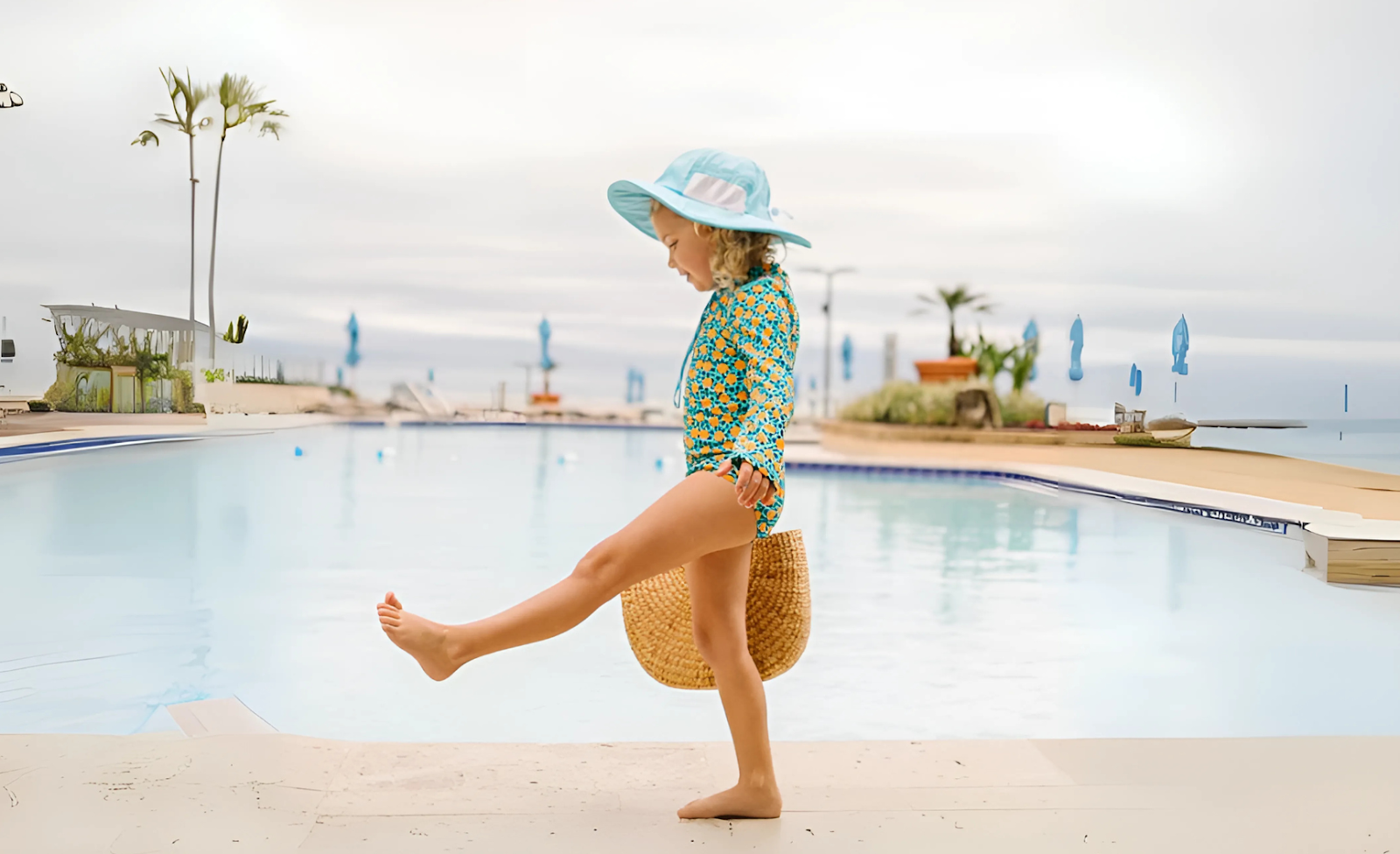
Hat brim length for sun protection: A sizing guide
Most people grab a nice-looking sun hat and assume they're covered, but narrow brims leave your neck, ears, and shoulders exposed to harmful ultraviolet radiation. For full-brimmed sun hats, a three-inch brim length sufficiently protects your face and neck, but you'll want four or five inches to cover your shoulders and chest, too.
We'll discuss the sun protection you can expect from different brim lengths on full-brimmed sun hats and partially brimmed hats. We’ll also explain how hat material, shape, and color affect protection and comfort.
Check out our sun-protective hat guide to learn about all your summer hat options.
Hat brim size chart
Brim length measurements affect how much skin is shielded from the sun on full-brimmed hats.
2–3 inches: Basic face protection
Full-brimmed hats with 2–3 inch brims offer moderate coverage that shields your face and the top of your neck from sunlight. The brim extends outward all around the crown but may leave lower neck areas and ear tips exposed to UV radiation. These hats protect against moderate sun exposure but not for extended periods. Your lower neck, ears, and sides of your face need sunscreen or additional coverage to prevent burns during prolonged sun exposure.
3–4 inches: Comprehensive head coverage
This brim length shields your face, neck, and ears. Safari hats and bucket hats typically feature this brim length that circles your entire head. The structured design maintains its shape in wind and heat, keeping your protected areas consistently shaded. These brim lengths provide coverage for hiking, gardening, beach days, and other prolonged activities.
4–5 inches: Extended body protection
Wide-brim sun hats with 4–5 inch brim length protect from all-day sun exposure by casting shadows over your shoulders and upper chest. Floppy sun hats and structured wide-brim designs block UV rays from multiple angles. These brim lengths are effective for poolside lounging, long beach walks, outdoor festivals, or other situations where you'll spend hours in direct sunlight.
5+ inches: Maximum UV defense
Extra-long brims provide the most comprehensive coverage. They protect your shoulders, upper arms, and chest from direct and reflected UV radiation. Water, sand, and concrete surfaces bounce extra UV rays toward your skin. Oversized brims droop to protect from all angles. They're your best choice for beach vacations, boating trips, outdoor work, and any high-UV situation where you need maximum protection.
Add a neck flap for complete protection
Any hat becomes more protective when paired with a neck flap that drapes over your shoulders. Adult and kids' hats with neck flaps add back-of-neck coverage that even the longest brims can't reach. The neck flap stays in place during windy conditions and active movement, protecting areas where sunscreen often washes away during swimming or sweating.
For children who need long brims and neck coverage, our collection of kids' wide-brim hats with neck flaps offers maximum protection in a single design.
Width for partial-brimmed hats
When purchasing partial-brimmed hats, like baseball caps or visors, brim width is as important as brim length. These hats provide limited face protection but leave your neck, ears, and sides of your face completely exposed to UV radiation. The narrow width means coverage only extends directly in front of your face. Look for hats with a 2–3 inch brim width. Anything less will leave the sides of your face exposed.
Since partially brimmed hats expose the neck, we recommend legionnaire hats. They combine a moderate front brim width with extended neck flaps that provide back and side coverage. Try our kids’ flap hats if shopping for the little ones.
Ultimately, the best brim width is a full brim. Full-brimmed hats shield you from every angle with consistent coverage that kids' wide-brim designs and our Adult Wide Brim Sun Hats with UPF 50 deliver during long days outdoors.
What is the best fabric for sun protection?
Tightly woven synthetic fabrics give the strongest sun protection. Polyester and nylon fabrics weave into dense barriers that UV rays can't penetrate. Synthetic fabrics resist stretching and fading, so their protection lasts longer than natural fibers.
Dense natural fabrics such as canvas, twill, and heavy cotton also block UV rays when tightly woven. Natural fabrics feel cool against your skin but might stretch or fade faster than synthetics.
Avoid loose-weave straw that lets sunlight pass through the fibers. Check fabric density by holding it up to bright light. The less light you see through the material, the better it blocks UV rays.
SwimZip uses certified UPF 50+ fabric in all our sun hats and swimwear. Every fabric batch gets tested for maximum protection that lasts through swimming, washing, and daily wear.
What hat shape is best for sun protection?
The shape of your sun hat determines coverage area, wind resistance, and how well the brim maintains its protective position during movement.
- Structured flat brims maintain consistent coverage because they won't droop or bend in wind and weather. Your protected areas are shaded from all angles.
- Legionnaire-style brims feature a wide front brim combined with extended neck flaps that drape over your shoulders. Side flaps cover your ears and temples for maximum coverage.
- Flexible wide brims on floppy sun hats shield from the sun and cast deep shadows over your shoulders, though they may shift position in windy conditions.
- Sloped brims on bucket hats channel rain away from your face while providing modest coverage that keeps your view clear during activities.
- Curved brims on cowboy hats curve up at the sides to keep your arms free to move, but this reduces protection for your ears compared to flat designs.
- Rigid safari brims circle the entire crown to block the sun from every angle, with structured construction that maintains its shape in heat and humidity.
Girls' wide-brim sun hats feature structured brim designs that maintain their shape during active play, while women's wide-brim sun hats offer the same reliable coverage in styles that complement adult activities.
How should a brimmed hat fit?
Your hat should fit snugly without creating pressure points. The crown shouldn't wobble or slide when you move, and the brim should stay level for consistent coverage. A loose hat shifts in the wind, creating gaps where UV rays can reach your skin.
Measure your head circumference just above your ears and eyebrows with a soft measuring tape. Wrap the tape snugly but not tightly around the widest part of your head, keeping it level all the way around.
For children, measure every few months as head sizes change rapidly. A well-fitted hat feels comfortable even after hours of wear without pressure points or gaps. Match your measurement to SwimZip's size chart and choose from our available size options.
What color hat is best for sun protection?
Color matters less than you think when your hat has UPF-rated fabric. A light-colored hat with UPF 50+ protection beats a dark hat made from thin material every time.
Here's what you need to know:
- Darker colors block more UV rays than light shades. Black, navy, and deep colors absorb radiation before it reaches your skin, but they also trap more heat during summer days.
- Light colors reflect more heat than dark colors and keep your head cool. White, tan, and pale shades improve air circulation between the hat and your head.
- Choose dark colors for high-UV situations when you need maximum protection.
- Go with light shades for casual adventures and long days when staying cool matters more than squeezing out every bit of UV defense.
- Focus on fabric quality first, then pick colors that suit your style and activities.
The same color principles apply to your swimwear. Color-block sun protective swimwear combines different shades for style while maintaining UPF 50+ protection across all color combinations.
Complete sun protection with SwimZip
Your hat is just the top layer of sun protection. Combine it with UPF 50+ sun-protective swimwear for full outdoor protection. SwimZip's coordinated clothing offers excellent sun protection for the whole family.
Add broad-spectrum sunscreen to exposed areas that your protective brim doesn't cover. Apply SPF 30+ to your hands, feet, and any skin not protected by clothing or your wide-brimmed hat.
UV-protective polarized sunglasses and other swimwear accessories shield your eyes from direct UV light that slips under your hat brim. Choose wraparound styles with 100% UV protection for complete eye safety during casual adventures and outdoor activities.
SwimZip's sun protection carries the Skin Cancer Foundation Seal of Recommendation. Our fabrics provide medical-grade protection that board-certified dermatologists recommend for preventing skin damage and reducing cancer risk.
When you choose SwimZip, you're choosing dependable UV protection that meets the highest safety standards.
Sun hat brim length FAQ
What UV index should you wear a hat for?
Wear a hat at any UV level above 3. High-UV-index days (6+) require hats with larger brimsand UPF 50+ fabric for adequate protection. Even during cloudy weather, UV rays penetrate clouds and can cause skin damage. Extended hikes, kayaking trips, and outdoor adventures need hat protection regardless of UV readings.
Do long sleeves protect from the sun?
Long sleeves provide excellent sun protection. UPF-rated fabric blocks harmful rays even better than regular clothing. Lightweight long sleeves work well for hiking at altitude, extended outdoor adventures, and hot weather when you need coverage without overheating. Choose breathable synthetic fabrics that offer UV protection while maintaining air circulation for comfort during summer days.
Are bucket hats good for sun protection?
Bucket hats offer solid coverage with their 2–3 inch brim length that circles the crown. The stiff brim slopes downward to shield your face and neck from direct rays without obstructing your field of vision. These hats pack flat for gear for travel and spring back to their original shape. Bucket hats are tailor-made for casual adventures, extended hikes, and water activities when you need reliable coverage without bulk.
Do hat brims lose protection over time?
Hat brims can lose protection through wear and stretching of the outer fabric. Heavy material maintains protection longer than thin fabrics. Check for fabric softener damage, fading, or loose weaving that lets light through. Replace hats when the brim loses its structure or shows signs of deterioration.
What hat materials should you avoid for sun protection?
Avoid loose-weave natural fibers, like thin cotton or African straw, that allow UV rays to penetrate. These materials may look stylish but offer poor protection compared to tightly woven synthetic fabrics. Choose hats made from nylon fabric or other synthetic fabrics with mesh ventilation for breathability without compromising protection. The underside brim should also use UV-blocking material for reflected UV radiation protection.
How do you care for sun hats to maintain protection?
Proper care prevents fabric softeners from breaking down UV protection in your hat's outer fabric.
- Wash gently with mild dish soap and use a soft toothbrush or gentle brush to remove difficult stains without damaging the structured brim.
- Avoid fabric softeners. They can reduce UPF ratings over time.
- Heavy material hats maintain their shape better during washing, while lighter color hats may show stains more easily.
- Always check the underside brim for wear that could compromise protection from extra UV exposure.
Do different hair types affect hat fit and comfort?
Different hair types impact how hats fit and feel during wear. Wavy hair creates more volume under the crown, requiring larger head sizes or adjustable bands. People with thick hair may find their hair in tangles when removing tight-fitting hats after extended hikes or casual adventures. The accumulation of sweat varies with different hair types, affecting comfort during hot weather activities. Choose hats with mesh ventilation and proper size options to accommodate your hair while maintaining the protective brim position for optimal forms of sun protection.
Further reading
Check our collection of winter sun hats
Our complete guide to swimwear fabrics



Leave a comment
This site is protected by hCaptcha and the hCaptcha Privacy Policy and Terms of Service apply.